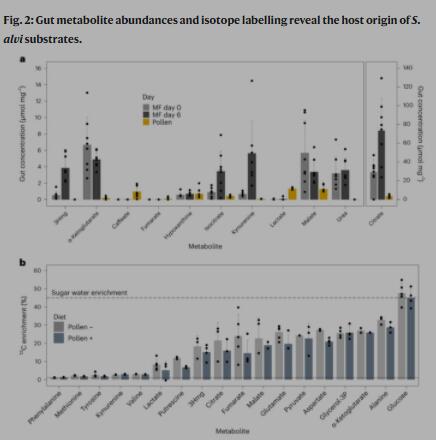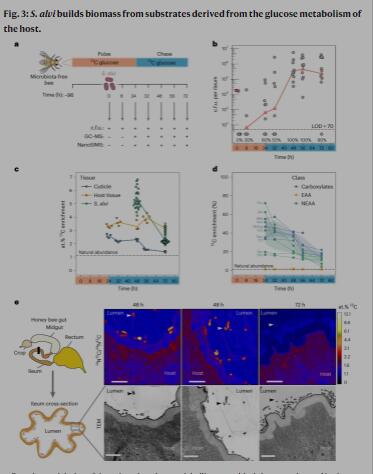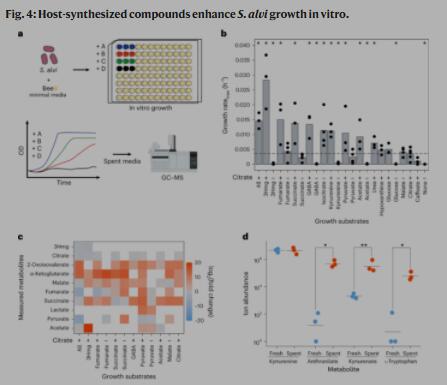Host-derived organic acids enable gut colonization ofthe honey bee symbiont Snodgrassella alvi
Abstract
Diverse bacteria can colonize the animal gut using dietary nutrients or by engaging inmicrobial crossfeeding interactions. Less is known about the role of host-derived nutrients inenabling gut bacterial colonization. Here we examined metabolic interactions within theevolutionary ancient symbiosis between the honey bee (Apis mellifera) and the coregutmicrobiota member Snodgrassella alui.This betaproteobacterium is incapable ofmetabolizing saccharides, yet colonizes the honey bee gut in the presence of a sugar-onlydiet. Using comparative metabolomics,13C-tracers and nanoscale secondary ion massspectrometry(NanoSIMS), we show in vivo that S. alui grows on host-derived organic acids,including citrate, glycerate and 3-hydroxy-3-methylglutarate, which are actively secreted bythe host into the gut lumen. S. alvi also modulates tryptophan metabolism in the gut byconverting kynurenine to anthranilate. These results suggest that S. alui is adapted to aspecific metabolic niche in the honey bee gut that depends on host-derived nutritionalresources.

Main
Gut bacteria and their hosts typically engage in mutualistic interactions. Metabolic exchangefrom the gut microbiota to the host is vital for uptake of essential nutrients, gut health andimmune system function-.In turn, bacteria profit from a stable niche environment andfrequent supply ofexogenous food. The role of host-secreted metabolites that benefitbacteria in the gut is less well understood. Such metabolic exchange is difficult to identify dueto the overwhelming contributions of the diet and microbial products towards gutmetabolites.
Deciphering the extent to which host metabolite secretion drives microbial colonization ofnative symbionts is aided by a simple, tractable system in which diet and microbiota-derivedmetabolites can be tightly controlled. The Western honey bee (Apis mellifera) provides such asystem. Its gut microbiota is broadly stable and composed of only eight to ten genera2,3 manyof which have longstanding evolutionary associations with their host that date back to theemergence of social bees >80 million years ago4,5.6, Bacteria of these genera are culturableand can be inoculated individually or as defined communities into gnotobiotic bees7.Furthermore, while the honey bee diet features arich mixture ofcompounds found in nectarand pollen, bees can survive for extended periods on pure sugar water diets8.
Most members ofthe bee gut microbiome are primary fermenters,possessing a broad rangeof carbohydrate degradation enzymes that enable them to use hemicellulose, pectin, starchor glycosides found in pollen3,9. A notable exception is the Betaproteobacteria Snodgrassellaalvi. It colonizes the cuticular surfaces of the ileum in the hindgut and displays a markedlydifferent metabolism10,11, Lacking a functional glycolysis pathway, S. alui profits from acids inthe gut,generating energy from an aerobic tricarboxylic acid (TCA) cycle and biomassthrough gluconeogenesisFermentation by other microbial members has been proposed asthe primary source ofshort chain fatty acids (SCFAs) consumed by S. alui. In particular,bacteria of the gammaproteobacterial genus Gilliamella are probably mutualistic partnersfor metabolic crosstalk, as they colocalize with S. alvi within biofilms attached to the cuticularsurface in the ileum and share complementary metabolic capabilitiesl0. Experimentalevidence from in vitro growth experiments bolstered this hypothesis, showing that S. aluigrows on the spent media of Gilliamella, while consuming numerous products oftheGilliamella metabolism, such as succinate and pyruvatel2.
Although a strong case can be made for niche exploitation through bacterial crossfeeding.this does not explain previous results in which S. alvi was able to monocolonize bees fed dietsof sugar water and pollen12, To better understand the nutrient sources that S. alvi exploits, weprovided bees with a simple (sugar water) or complex (sugar water and pollen) diet andcolonized them with S. alui alone or together with divergent strains of the genus Gilliamella.Surprisingly, we found that a simple sugar water diet was suficient for S. alvi to colonize thehoney bee gut. Subsequent metabolomics analysis indicated that host-derived carboxylicacids enable S. alvi colonization. We validated this with a series of experiments showing that(1) these carboxylic acids are synthesized by the host,(2) S. alui uses them for growth and (3)the findings hold across a range of divergent Snodgrassella strains and species.





https://doi.org/10.1038/s41564-023-01572-y
|












